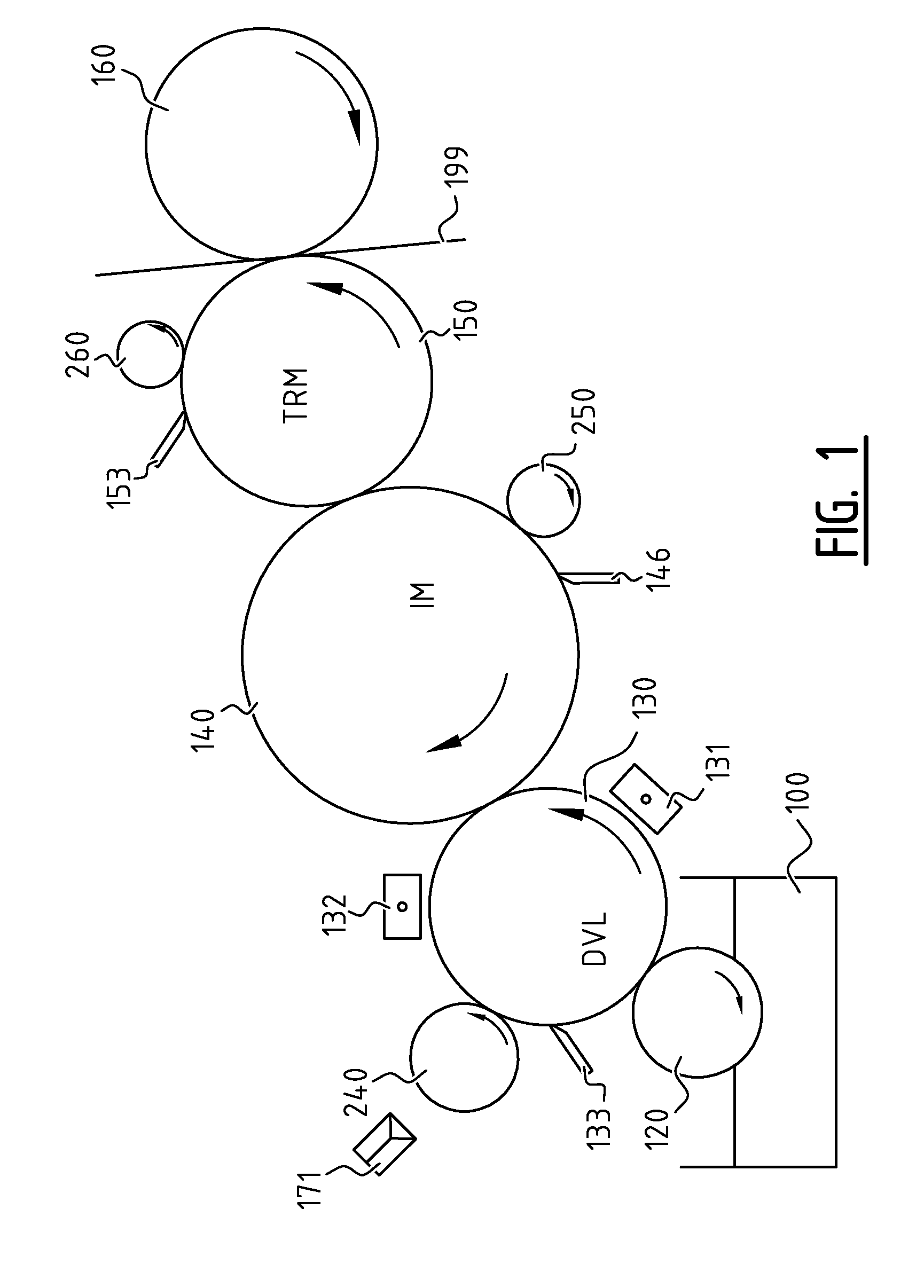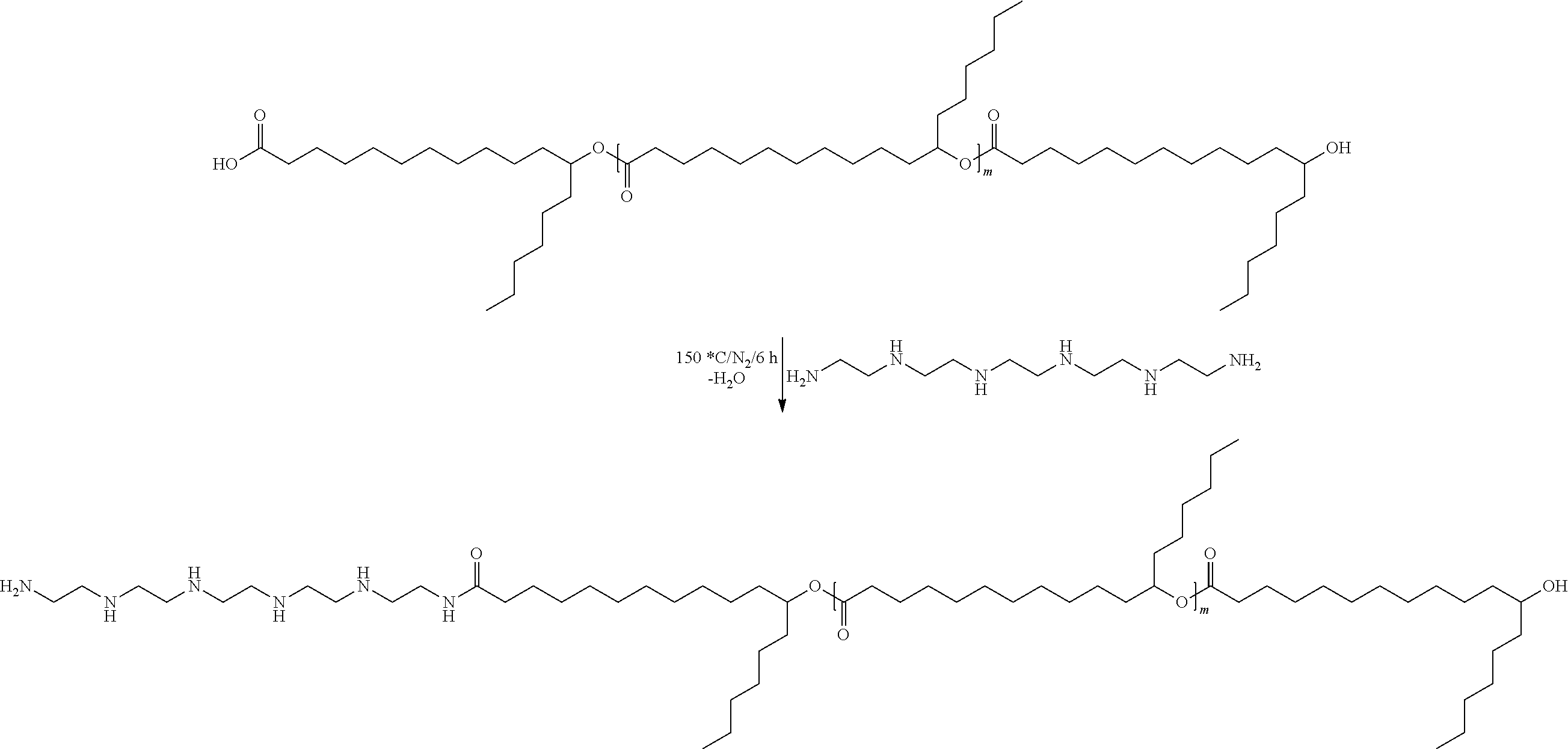Liquid Toner Dispersion and Use Thereof
- Summary
- Abstract
- Description
- Claims
- Application Information
AI Technical Summary
Benefits of technology
Problems solved by technology
Method used
Image
Examples
example 1
Synthesis of Polyhydroxystearic Acid (PHSA)
[0058]In a 1 L flask equipped with a Dean-Stark apparatus and a reflux condenser, there are added 400 g of 12-hydroxyoctadecanoic acid (12-hydroxystearic acid), 1 ml titanium (IV) butoxide and 120 ml xylene. The reaction mixture is heated under nitrogen in an oil bath at 200° C., and refluxed for 30 h. The progress of the reaction can be monitored by the amount of separated water. The degree of condensation was determined by means of IR and titration. In the IR spectrum the carbonyl stretch ratio of the carboxylic acid and the ester is a measure of the degree of condensation. By means of titration, the acid value can be determined. In this example, 20 mg KOH / g was obtained, which is a value of 8 or 10 HSA (m=6-8) units and a Mw of 2800 g / mol.
[0059]Poly(hydroxystearic acid) with another degree of polymerisation and other fatty acid polymers may be prepared in analogue manner. Generally, as mentioned before, the compound may be present in a d...
example 2
Coupling of Polyethylenimine (PEI) with 12-Hydroxystearic Acid (PHSA)
[0060]10 g pentaethylenehexamine was heated with 120.5 g PHSA (Mw 2800) under a nitrogen flow for 6 hours at 150° C. After cooling, an oily substance is obtained that can be used as such.
[0061]The dispersing agents mentioned in table 2 were prepared according the above method according to the composition as mentioned in table 2.
Examples with the Liquid Toner Dispersion
[0062]Various tests have been carried out in accordance with the invention.
Test Methods
[0063]The viscosity of the liquid developer dispersion and carrier liquid is measured with a Haake Rheostress RS6000 operated in shear rate sweep from 0.1 to 3000 l / s at 25° C. The instrument is equipped with a cone / plate geometry type C60 / 1° and the gap is set to 0.052 mm. The viscosity is measured, on the basis of the operation in shear rate sweep, at a value of 0.88 l / s. The measurements are carried out at the beginning and after the caking test and at r...
examples
[0068]Several liquid developer dispersions are prepared and comprise a marking particle, a carrier liquid and a dispersing agent. A marking particle was prepared by kneading a polyester resin with pigment. The ingredients used to prepare the marking particles and the liquid developer dispersions are summarised in table 1.
[0069]The marking particles are prepared by kneading the ingredient as mentioned in table 1 at a temperature of 100 to 120° C. for 45 minutes. This mixture is cooled down and milled down to 10 μm by a fluidised bed mill
TABLE 1composition of marking particlesconcPolymerconcPigmentconcAdditive(w / wnamename(w / w %)Name(w / w %)name%)MAR1PM187.5PIG112.5MAR2PM181.5PIG112.5AD16PM1 = polyester resin Tg = 60° C. and Tm = 100° C. and acid value of 12 mg KOH / grPIG1 = copper phthalocyanine PB15:3 (Heligen blau D7079)AD1 = toluenesulfonamide additive
[0070]Afterwards the liquid developer dispersions are prepared as mentioned in table 3 based on the dispersing agents as mentioned in ...
PUM
 Login to View More
Login to View More Abstract
Description
Claims
Application Information
 Login to View More
Login to View More - R&D
- Intellectual Property
- Life Sciences
- Materials
- Tech Scout
- Unparalleled Data Quality
- Higher Quality Content
- 60% Fewer Hallucinations
Browse by: Latest US Patents, China's latest patents, Technical Efficacy Thesaurus, Application Domain, Technology Topic, Popular Technical Reports.
© 2025 PatSnap. All rights reserved.Legal|Privacy policy|Modern Slavery Act Transparency Statement|Sitemap|About US| Contact US: help@patsnap.com



